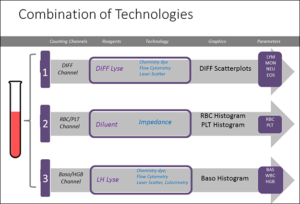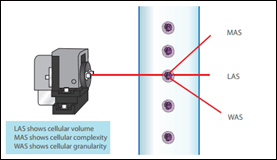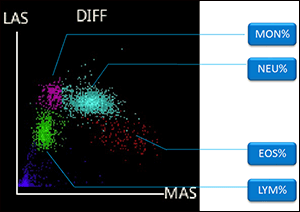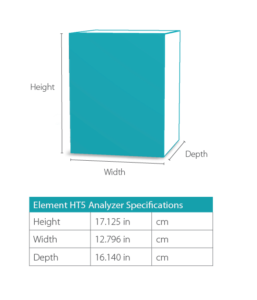Menu
A true 5-part CBC differential in under 1 minute
The Element HT5 determines a hematological blood count with 20 parameters in less than one minute. To determine a blood count, the Element HT5 takes only 15 L EDTA whole blood. The small sample volume proves to be a practical advantage, especially for small patients.
Available Species:
Dog, Cat, Horse, Cow, Ferret, Goat, Llama, Monkey, Mouse, Pig, Rabbit, Rat, Sheep, Giant Panda, and Red Panda.
Interfaces:
4 USB ports
1 Ethernet Port
Power Supply:
Voltage Input power Frequency: Analyzer (100V-240V~)±10% 300 VA (50Hz/60Hz)±1Hz
Fuse:
WARNING: Use specified fuse only. Fuse specification: 250V T3.15AH
EMC Description:
Do not use this device in close proximity to sources of strong electromagnetic radiation (e.g., unshielded intentional RF sources), as these may interfere with the proper operation. This equipment complies with the emission and immunity requirements of the EN61326–1:2006 and EN61326–2–6:2006.
NOTE: It is the manufacturer’s responsibility to provide equipment electromagnetic compatibility information to the customer or user.
NOTE: It is the user’s responsibility to ensure that a compatible electromagnetic environment for the equipment can be maintained in order that the device will perform as intended.
Sound:
Maximal sound: 65 dBA
Operating Environment:
Optimal operating temperature: 10°C – 30°C (50°F – 86°F)
Optimal operating humidity: 20% – 85%
Atmospheric pressure: 70 kPa – 106 kPa
Storage Environment:
Ambient temperature: -9.5°C – 40°C (15°F – 104°F)
Relative humidity: 10% – 90%
Atmospheric pressure: 50 kPa – 106 kPa
Running Environment:
Ambient temperature: 10°C – 40°C (50°F – 104°F)
Relative humidity: 10% – 90%
Atmospheric pressure: 70 kPa – 106 kPa
NOTE: Be sure to use and store the analyzer in the specified environment
Superior Technology Three Measuring Techniques Used:
Electrical Impedance technique for RBC and PLT data determination
Colorimetric Method for the Determination of HGB Laser Flow Cytometry for the Determination of WBC Data
Other parameter outcomes are calculated

1. Method of Electrical Impedance
Electrical impedance is utilized to count and measure RBCs/PLTs. This method is based on the measurement of changes in electrical resistance induced by a particle, in this case, a blood cell, as it passes through an aperture with defined dimensions. On both sides of the aperture, a pair of electrodes are submerged in the liquid to establish an electrical route. As each particle travels through the aperture, there is a momentary change in the resistance between the electrodes. This modification generates a detectable electrical pulse. The number of generated pulses is proportional to the number of particles that traveled through the aperture. Each pulse’s amplitude is related to the particle’s volume.
Included in the output are numerical values, percentages, and histograms for RBC, WBC, and PLT, as well as scatter plots for assessing cell volume, complexity, and granularity.
2. Laser Flow Cytometry
After aspirating a predetermined volume of blood and diluting it with a certain amount of reagent, the blood is injected into the flow cell. Blood cells surrounded by sheath fluid (diluent) travel through the center of the flow cell in a single column at a faster velocity. The blood cells suspended in the diluent are exposed to a laser beam as they move through the flow cell.
The intensity of scattered light reflects the size and intracellular density of blood cells. Cell size is reflected by low-angle scattered light, while intracellular density is reflected by high-angle scattered light (nucleus size and density). This scattered light is received by the optical detector and converted into electrical pulses. The obtained pulse data can be utilized to create a three-dimensional distribution (scattergram).
Triple angle scatter detects cell volume, complexity and granularity of cells.

Low Angle Scatter (LAS)-Detects Cell Volume
Mid Angle Scatter (MAS)- Detects Cellular Complexity
Wide Angle Scatter (WAS)-Detects Cellular Granularity
Multiple angle scatterplots aid to differentiate WBC differential
3. Colorimetric Procedure
The WBC/HGB dilution is transferred to the HGB bath, where it is bubble-mixed with a specified amount of lyse, which transforms hemoglobin to a 530 nm-measurable hemoglobin complex. On one side of the bath, an LED emits a monochromatic light beam with a center wavelength of 530 nm. The sample is illuminated by light, which is then measured by an optical sensor positioned on the opposite side. The signal is then amplified, the voltage is detected and compared to the blank reference reading (readings made when just diluent is present in the bath), and the HGB is automatically measured and calculated by the analyzer.

Reticulocytes
Typically, 5–10 percent of small animal samples contain anemia. In these situations, it is helpful to examine the blood for regeneration and RBC abnormalities, which can assist determine the source of the anemia. Heska advises examining the stained blood film for polychromasia (or reticulocytes) as well as RBC abnormalities as the optimal method for evaluating regeneration. The identification of an increase in RDW and/or MCV by the Element HT5 analyzer is suggestive of possible reticulocytosis, however this is best validated by slide examination.
Sample Pathology Messages
The Element HT5 technology provides pathology-related intelligent information messages. These messages are meant to serve as a guide to sample result criteria for slide review that may be implemented in a laboratory. These messages indicate that the slide may contain extra diagnostic information to enhance the instrument results.
Dimensions:

Just a sample text from heading element.
Just a sample text from heading element.